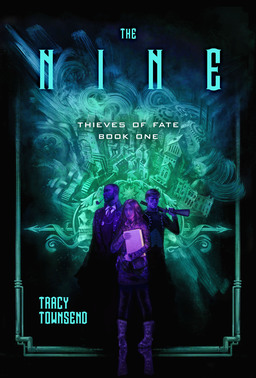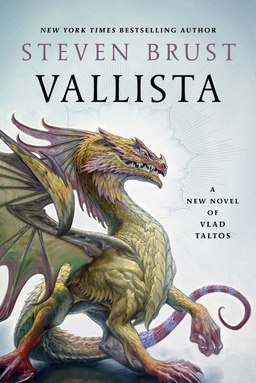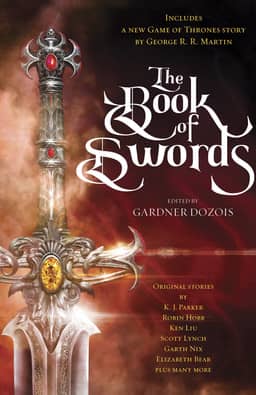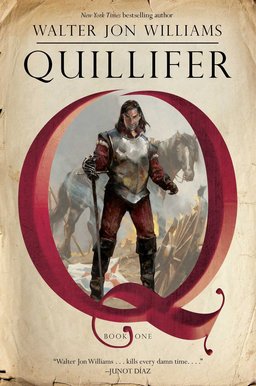RBE returns with a WWE-style SmackDown: Challenge! Discovery
Ahem. It’s been a tad longer than realized: almost exactly 4 years later, RBE reignites. What better way to light the conflagration then with Battle Royale?
Once upon a time…
Ahem. It’s been a tad longer than realized: almost exactly 4 years later, RBE reignites. What better way to light the conflagration then with Battle Royale?
Once upon a time…
 The Nine (Thieves of Fate #1)
The Nine (Thieves of Fate #1)
By Tracy Townsend
Pyr (400 pages, $17.99 paperback, $9.99 eBook, November 2017)
As an emerging author, I know that even once I land that coveted debut book deal, that’ll be the point when the real work begins. Completing a novel is one thing; afterward there’s the terrifying and unpredictable world of promoting the book and hoping that it does well enough that you can write a few more.
If my first novel is even half as good as Tracy Townsend’s The Nine, I will be well on my way.
Imagine a world where science and theology have been woven together, so that people believe not just in God, but in God the Experimenter, a rational entity controlling a world of Reason. Sort of like what the Enlightenment philosophes wanted – not to disprove God through science, but to show just how brilliant His world is by discovering more of its intricacies. Then imagine that God isn’t just observing His creation, but specifically testing nine individuals and recording everything they do, as a measure about whether His experimental world is a success. I’m not a religious person, but I’d be lying if I said that thought didn’t terrify me.
That’s the crux of The Nine, which explores a sort of steampunk world with just a hint of the magical, where people have electricity and gunpowder but tree- and ogre-like creatures coexist with humans (sort of) and people worry that magic might actually be real (until Reason proves otherwise!)
It’s an intricate and beautiful world that comes together slowly, but what really drew me in was the characters. For example, you have Anselm, the borderline cat burglar turned businessman and crime lord, who calls his lover Rare “kitten” in a way that’s almost a cliché – until he nicknames the young street urchin Rowena “cricket.” At first I thought he was following the same pattern of, well, lechery … but over time I realized Anselm was more honorable than I thought.
 Matthew David Surridge says John Crowley’s World Fantasy Award-winning Little, Big is “the best post-Tolkien novel of the fantastic I’ve read,” and Mark Rigney calls it “among the best and most endearing fantasy novels ever written… If there’s another book I’ve encountered in my adult life that calls louder to be re-read, and which reveals an even richer experience on doing so, I cannot imagine what it is.” Crowley’s thirteenth novel Ka, a fable about the first crow in history with a name of his own, arrives in hardcover from Saga Press next week.
Matthew David Surridge says John Crowley’s World Fantasy Award-winning Little, Big is “the best post-Tolkien novel of the fantastic I’ve read,” and Mark Rigney calls it “among the best and most endearing fantasy novels ever written… If there’s another book I’ve encountered in my adult life that calls louder to be re-read, and which reveals an even richer experience on doing so, I cannot imagine what it is.” Crowley’s thirteenth novel Ka, a fable about the first crow in history with a name of his own, arrives in hardcover from Saga Press next week.
A Crow alone is no Crow.
Dar Oakley — the first Crow in all of history with a name of his own — was born two thousand years ago. When a man learns his language, Dar finally gets the chance to tell his story. He begins his tale as a young man, and how he went down to the human underworld and got hold of the immortality meant for humans, long before Julius Caesar came into the Celtic lands; how he sailed West to America with the Irish monks searching for the Paradise of the Saints; and how he continuously went down into the land of the dead and returned. Through his adventures in Ka, the realm of Crows, and around the world, he found secrets that could change the humans’ entire way of life — and now may be the time to finally reveal them.
Our previous coverage of John Crowley includes:
In Praise of Little, Big by Mark Rigney
John Crowley’s Aegypt Cycle, Books One and Two by Mark Rigney
The Deep
Ka: Dar Oakley in the Ruin of Ymr will be published by Saga Press on October 24, 2017. It is 442 pages, priced at $28.99 in hardcover and $7.99 for the digital edition. The cover is by Melody Newcomb.
 Pirates, space stations, and a killer A.I… these are the promising ingredients in R. E. Stearns’ debut SF novel Barbary Station, in which two engineers hijack a spaceship to join a band of space pirates — only to discover the pirates are hiding from a malevolent AI. To join the pirate crew, they first have to prove themselves by outwitting the AI… how hard can that be? Barbary Station arrives in hardcover from Saga Press on Halloween.
Pirates, space stations, and a killer A.I… these are the promising ingredients in R. E. Stearns’ debut SF novel Barbary Station, in which two engineers hijack a spaceship to join a band of space pirates — only to discover the pirates are hiding from a malevolent AI. To join the pirate crew, they first have to prove themselves by outwitting the AI… how hard can that be? Barbary Station arrives in hardcover from Saga Press on Halloween.
Adda and Iridian are newly minted engineers, but aren’t able to find any work in a solar system ruined by economic collapse after an interplanetary war. Desperate for employment, they hijack a colony ship and plan to join a famed pirate crew living in luxury at Barbary Station, an abandoned shipbreaking station in deep space.
But when they arrive there, nothing is as expected. The pirates aren’t living in luxury — they’re hiding in a makeshift base welded onto the station’s exterior hull. The artificial intelligence controlling the station’s security system has gone mad, trying to kill all station residents and shooting down any ship that attempts to leave — so there’s no way out.
Adda and Iridian have one chance to earn a place on the pirate crew: destroy the artificial intelligence. The last engineer who went up against the AI met an untimely end, and the pirates are taking bets on how the newcomers will die. But Adda and Iridian plan to beat the odds.
There’s a glorious future in piracy… if only they can survive long enough.
Barbary Station will be published by Saga Press on October 31, 2017. It is 448 pages, priced at $27.99 in hardcover and $7.99 for the digital edition.
See all our recent coverage of the best upcoming SF ans Fantasy here.
Ed Hulse, editor and co-founder of pulp zine Blood ‘n Thunder, collector extraordinaire Robert Weinberg, and collector (and Black Gate blogger) Doug Ellis have teamed up to produce what may be my most anticipated book of 2017: The Art of the Pulps, a gorgeous 240-page celebration of the magazines that gave birth to the heart and soul of modern Pop Culture. Miss this book at your peril.
Experts in the ten major Pulp genres, from action Pulps to spicy Pulps and more, chart for the first time the complete history of Pulp magazines — the stories and their writers, the graphics and their artists, and, of course, the publishers, their market, and readers.
Each chapter in the book, which is illustrated with more than 400 examples of the best Pulp graphics (many from the editors’ collections — among the world’s largest) is organized in a clear and accessible way, starting with an introductory overview of the genre, followed by a selection of the best covers and interior graphics, organized chronologically through the chapter. All images are fully captioned (many are in essence “nutshell” histories in themselves). Two special features in each chapter focus on topics of particular interest (such as extended profiles of Daisy Bacon, Pulp author and editor of Love Story, the hugely successful romance Pulp, and of Harry Steeger, co-founder of Popular Publications in 1930 and originator of the “Shudder Pulp” genre).
With an overall introduction on “The Birth of the Pulps” by Doug Ellis, and with two additional chapters focusing on the great Pulp writers and the great Pulp artists, The Art of the Pulps covers every aspect of this fascinating genre; it is the first definitive visual history of the Pulps.
F. Paul Wilson provides the Foreword. The Art of the Pulps will be published by IDW Publishing on October 24, 2017. It is 240 pages, priced at $49.99 in hardcover. There is no digital edition.
 I read Jhereg, the first book in Steven Brust’s long-running Vlad Taltos series, when my brother Mike thrust it on me in 1983. It was fun, fast-paced, and totally different from anything I’d ever read before.
I read Jhereg, the first book in Steven Brust’s long-running Vlad Taltos series, when my brother Mike thrust it on me in 1983. It was fun, fast-paced, and totally different from anything I’d ever read before.
Steven Brust was a fast-rising literary star in 1983, but Jhereg, and the series it spawned, established him as a major name. He’s produced numerous popular and acclaimed novels in the intervening years — including To Reign in Hell (1984), Brokedown Palace (1985), The Phoenix Guards (1991), and his ongoing Incrementalists series with Skyler White — but it’s the Vlad Taltos series that he remains most closely associated with. There have been thirteen additional novels in the series since Jhereg appeared 34 years ago, and this month marks the arrival of the fifteenth, Vallista, a deep dive into the mysteries of the world of Dragaera.
Vlad Taltos is an Easterner ― an underprivileged human in an Empire of tall, powerful, long-lived Dragaerans. He made a career for himself in House Jhereg, the Dragaeran clan in charge of the Empire’s organized crime. But the day came when the Jhereg wanted Vlad dead, and he’s been on the run ever since. He has plenty of friends among the Dragaeran highborn, including an undead wizard and a god or two. But as long as the Jhereg have a price on his head, Vlad’s life is…messy.
Meanwhile, for years, Vlad’s path has been repeatedly crossed by Devera, a small Dragaeran girl of indeterminate powers who turns up at the oddest moments in his life.
Now Devera has appeared again ― to lead Vlad into a mysterious, seemingly empty manor overlooking the Great Sea. Inside this structure are corridors that double back on themselves, rooms that look out over other worlds, and ― just maybe ― answers to some of Vlad’s long-asked questions about his world and his place in it. If only Devera can be persuaded to stop disappearing in the middle of his conversations with her…
The entire series has been kept in print by Ace in deluxe trade paperback omnibus editions — pretty extraordinary for a series that’s over three decades old.
 A while back Gardner Dozois asked if I wanted a review copy of his upcoming “Sword & Sorcery” anthology, The Book of Swords.
A while back Gardner Dozois asked if I wanted a review copy of his upcoming “Sword & Sorcery” anthology, The Book of Swords.
Now, Gardner does not do small anthologies — neither in the physical sense, nor in the sense of their impact on the field. If the premier anthologist in the SF community was putting his time and energy into a collection of original sword & sorcery tales, then clearly the genre still has some life in it.
It wasn’t that long ago that I thought the era of big-budget (or even modest-budget) S&S anthologies was long over. What’s changed? The global phenomena that is GRRM’s Game of Thrones, that’s what’s changed. I don’t consider GoT to be sword & sorcery… but there’s no denying that publishers (and film producers) are a lot more interested in adventure fantasy all of a sudden. If the results are anything like The Book of Swords, I’m all for it.
The Book of Swords arrives next week in hardcover from Martin’s Song of Ice and Fire publisher Bantam Books, with sixteen brand new stories by Lavie Tidhar, Robin Hobb, Ken Liu, Matthew Hughes, Walter Jon Williams, C. J. Cherryh, Garth Nix, Ellen Kushner, Scott Lynch — and, yes, a brand new Song of Ice and Fire story from George R. R. Martin.
Fantasy fiction has produced some of the most unforgettable heroes ever conjured onto the page: Robert E. Howard’s Conan the Barbarian, Michael Moorcock’s Elric of Melniboné, Fritz Leiber’s Fafhrd and the Gray Mouser. Classic characters like these made sword and sorcery a storytelling sensation, a cornerstone of fantasy fiction — and an inspiration for a new generation of writers, spinning their own outsize tales of magic and swashbuckling adventure.
Now, in The Book of Swords, acclaimed editor and bestselling author Gardner Dozois presents an all-new anthology of original epic tales by a stellar cast of award-winning modern masters — many of them set in their authors’ best-loved worlds. Join today’s finest tellers of fantastic tales, including George R. R. Martin, K. J. Parker, Robin Hobb, Scott Lynch, Ken Liu, C. J. Cherryh, Daniel Abraham, Lavie Tidhar, Ellen Kushner, and more on action-packed journeys into the outer realms of dark enchantment and intrepid derring-do, featuring a stunning assortment of fearless swordsmen and warrior women who face down danger and death at every turn with courage, cunning, and cold steel.
Here’s the complete Table of Contents.
 |
 |
I’ve heard a lot of praise heaped on Algernon Blackwood’s 1908 collection John Silence–Physician Extraordinary over the years. In his review of Blackwood’s 1914 collection Incredible Adventures, Ryan Harvey wrote:
Of all the practitioners of the classic “weird tale,” which flourished in the early twentieth century before morphing into the more easily discerned genres of fantasy and horror, none entrances me more than Algernon Blackwood. Looking at the stable of the foundational authors of horror — luminaries like Poe, James, le Fanu, Machen, Lovecraft — it is Blackwood who has the strongest effect on me. Of all his lofty company, he is the one who seems to achieve the most numinous “weird” of all…
In my view, Blackwood achieved his finest work in his earlier collections The Listener and Other Stories (1907), John Silence — Physician Extraordinary (1908), and The Lost Valley and Other Stories (1910), where he combined his weird adventures with aspects of horror and fear. These earlier classics are supernatural horror, but are also superb works of mood.
Josh Reynolds discussed the collection in detail as part of his occult detective series The Nightmare Men here at Black Gate.
Check out the cool bookmark that came with my review copy of The Tiger’s Daughter, the debut novel by K Arsenault Rivera!
It’s instructing me to “Plant flower seed paper under 1/8″ of soil. Water thoroughly.” Okay, but…. what does it GROW? A geranium? Violets? An alien seed pod like that horrifying episode of Johnny Sokko?
I guess there’s only one way to find out. And it involves sticking this super-cool book collectible in a bunch of dirt. Marketing departments, man. They thrive on cruelty.
 It’s been a good week for review copies here at Black Gate (see some of the recent arrivals here). But the moment Quillifer arrived, I knew it was the most significant release of the current crop, by a pretty good margin.
It’s been a good week for review copies here at Black Gate (see some of the recent arrivals here). But the moment Quillifer arrived, I knew it was the most significant release of the current crop, by a pretty good margin.
Walter Jon Williams has had an extraordinary career, displaying an easy mastery of cyberpunk (Hardwired, Angel Station), military SF (Dread Empire’s Fall), SF police procedural (Days of Atonement), light-hearted fantasy (the Majistral series), space opera (Aristoi), contemporary disaster (The Rift), and even the Star Wars universe (The New Jedi Order: Destiny’s Way).
Quillifer, the tale of a young man forced to flee his beloved home and find his fortune among goddesses, pirates, war, and dragons, is his long-awaited foray into epic fantasy. It’s the first in an ambitious new series from one of the most respected authors in the genre.
Quillifer is young, serially in love, studying law, and living each day keenly aware that his beloved homeport of Ethlebight risks closure due to silting of the harbor. His concerns for the future become much more immediate when he returns from a summery assignation to find his city attacked by Aekoi pirates, leading to brigands in the streets and his family and friends in chains.
First, he has to survive the night. Then, he has to leave his home behind and venture forth into the wider world of Duisland, where he can find friends and allies to help avenge his losses and restore Ethlebight to glory. His determination will rock kingdoms, shatter the political structure of Duisland, and change the country forever.
Quillifer will be published by Saga Press on October 3, 2017. It is 530 pages, priced at $27.99 in hardcover and $7.99 for the digital edition. The cover is by Gregory Manchess. Learn more at Williams’ website, and read Emily Mah’s interview with the author (“Why UFOs Are Actually Made of Bread, and Other Little Known Facts”) here.